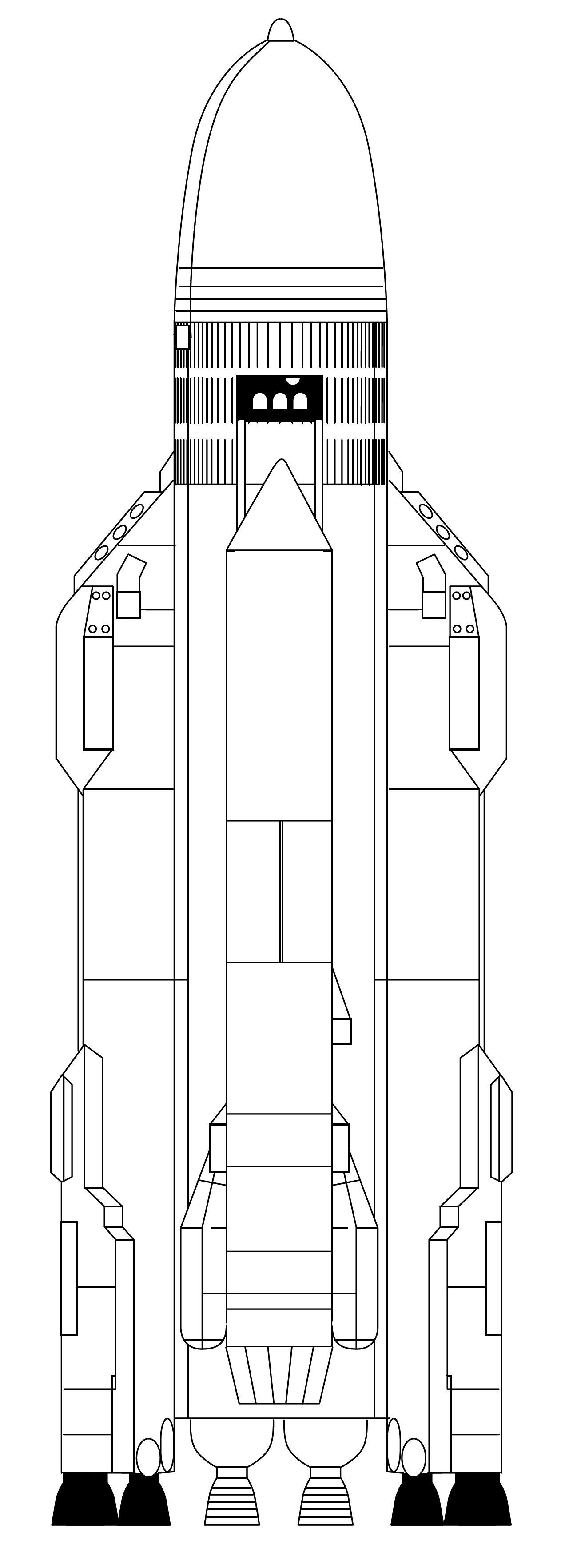|
RD-0120
The Soviet RD-0120 (also designated 11D122) was the Energia core rocket engine, fueled by LH/ LOX, roughly equivalent to the Space Shuttle Main Engine (SSME). These were attached to the Energia core rather than the orbiter, so were not recoverable after a flight, but created a more modular design (the Energia core could be used for a variety of missions besides launching the shuttle). The RD-0120 and the SSME have both similarities and differences. The RD-0120 achieved a slightly higher specific impulse and combustion chamber pressure with reduced complexity and cost (but it was single-use), as compared to the SSME. It uses a fuel-rich staged combustion cycle and a single shaft to drive both the fuel and oxidizer turbopumps. Some of the Russian design features, such as the simpler and cheaper channel wall nozzles, were evaluated by Rocketdyne for possible upgrades to the SSME. It achieved combustion stability without the acoustic resonance chambers that the SSME required. Spe ... [...More Info...] [...Related Items...] OR: [Wikipedia] [Google] [Baidu] |
Chemical Automatics Design Bureau
Chemical Automatics Design Bureau (CADB), also KB Khimavtomatika (russian: Конструкторское бюро химавтоматики, КБХА, KBKhA), is a Russian design bureau founded by the NKAP (People's Commissariat of the Aircraft Industry) in 1941 and led by Semyon Kosberg until his death in 1965. Its origin dates back to a 1940 Moscow carburetor factory, evacuated to Berdsk in 1941, and then relocated to Voronezh city in 1945, where it now operates. Originally designated OKB-296 and tasked to develop fuel equipment for aviation engines, it was redesignated OKB-154 in 1946. In 1965 took over leadership. He was succeeded by in 1993, then by (RD-0124 Chief designer) in 2015. During this time the company designed a wide range of high technology products, including liquid propellant rocket engines, a nuclear reactor for space use, the first Soviet laser with an output of 1 MW and the USSR's only operational nuclear rocket engine. The company has designed more t ... [...More Info...] [...Related Items...] OR: [Wikipedia] [Google] [Baidu] |
Energia (rocket)
Energia (russian: Энергия, Energiya, Energy; GRAU 11K25) was a 1980s super-heavy lift launch vehicle. It was designed by NPO Energia of the Soviet Union as part of the Buran program for a variety of payloads including the Buran spacecraft. Control system main developer enterprise was the Khartron NPO "Electropribor". The Energia used four strap-on boosters each powered by a four-chamber RD-170 engine burning kerosene/ LOX, and a central core stage with four single-chamber RD-0120 (11D122) engines fueled by liquid hydrogen/LOX. The launch vehicle had two functionally different operational variants: Energia-Polyus, the initial test configuration, in which the Polyus system was used as a final stage intended to put the payload into orbit, and Energia-Buran, in which the ''Buran'' orbiter was the payload and the source of the orbit insertion impulse. The launch vehicle had the capacity to place about 100 tonnes in Low Earth orbit, up to 20 tonnes to geostationary orb ... [...More Info...] [...Related Items...] OR: [Wikipedia] [Google] [Baidu] |
Voronezh Mechanical Plant
Voronezh Mechanical Plant ( Russian: , ''ВМЗ'') is a Russian engine and heavy machinery manufacturing plant. It is located in the city of Voronezh, in the Voronezh Oblast. History Voronezh Mechanical Plant started as a diesel engine manufacturing plant, and has been the plant that serially manufactures the engines designed by Chemical Automatics Design Bureau (KBKhA). In later years, it has branched into producing oil and gas products like valves, manifolds and fittings. In January 2017, Roscosmos announced that firing tests revealed problems with the Voronezh-produced Proton rocket upper stage engines. According to the investigation, expensive alloys had been replaced by cheaper less heat-resistant alloys. Voronezh director-general Ivan Tikhonovich Koptev resigned. On November 1, 2019, enterprises ''ВМЗ'' and the Chemical Automatics Design Bureau were merged. Products Current engines Engines in production at the plant as of 2015: * RD-0110 - Upper stage engine of ... [...More Info...] [...Related Items...] OR: [Wikipedia] [Google] [Baidu] |
Staged Combustion Cycle
The staged combustion cycle (sometimes known as topping cycle, preburner cycle, or closed cycle) is a power cycle of a bipropellant rocket engine. In the staged combustion cycle, propellant flows through multiple combustion chambers, and is thus combusted in stages. The main advantage relative to other rocket engine power cycles is high fuel efficiency, measured through specific impulse, while its main disadvantage is engineering complexity. Typically, propellant flows through two kinds of combustion chambers; the first called preburner and the second called main combustion chamber. In the preburner, a small portion of propellant, usually fuel-rich, is partly combusted, and the increasing volume flow is used to drive the turbopumps that feed the engine with propellant. The gas is then injected into the main combustion chamber and combusted completely with the other propellant to produce thrust. Tradeoffs The main advantage is fuel efficiency due to all of the propellan ... [...More Info...] [...Related Items...] OR: [Wikipedia] [Google] [Baidu] |
Soviet Union
The Soviet Union,. officially the Union of Soviet Socialist Republics. (USSR),. was a List of former transcontinental countries#Since 1700, transcontinental country that spanned much of Eurasia from 1922 to 1991. A flagship communist state, it was nominally a Federation, federal union of Republics of the Soviet Union, fifteen national republics; in practice, both Government of the Soviet Union, its government and Economy of the Soviet Union, its economy were highly Soviet-type economic planning, centralized until its final years. It was a one-party state governed by the Communist Party of the Soviet Union, with the city of Moscow serving as its capital as well as that of its largest and most populous republic: the Russian Soviet Federative Socialist Republic, Russian SFSR. Other major cities included Saint Petersburg, Leningrad (Russian SFSR), Kyiv, Kiev (Ukrainian Soviet Socialist Republic, Ukrainian SSR), Minsk (Byelorussian Soviet Socialist Republic, Byelorussian SSR), Tas ... [...More Info...] [...Related Items...] OR: [Wikipedia] [Google] [Baidu] |
Soviet Inventions
This timeline of Russian Innovation encompasses key events in the history of technology in Russia, from the Grand Duchy of Moscow up to the Russian Federation. The entries in this timeline fall into the following categories: * indigenous inventions, like airliners, AC transformers, radio receivers, television, artificial satellites, ICBMs * uniquely Russian products, objects and events, like Saint Basil's Cathedral, Matryoshka dolls, Russian vodka * products and objects with superlative characteristics, like the Tsar Bomba, the AK-47, and the Typhoon-class submarine * scientific and medical discoveries, like the periodic law, vitamins and stem cells This timeline includes scientific and medical discoveries, products and technologies introduced by various peoples of Russia and its predecessor states, regardless of ethnicity, and also lists inventions by naturalized immigrant citizens. Certain innovations achieved internationally may also appear in this timeline in ca ... [...More Info...] [...Related Items...] OR: [Wikipedia] [Google] [Baidu] |
Rocket Engines Using Hydrogen Propellant
A rocket (from it, rocchetto, , bobbin/spool) is a vehicle that uses jet propulsion to accelerate without using the surrounding air. A rocket engine produces thrust by reaction to exhaust expelled at high speed. Rocket engines work entirely from propellant carried within the vehicle; therefore a rocket can fly in the vacuum of space. Rockets work more efficiently in a vacuum and incur a loss of thrust due to the opposing pressure of the atmosphere. Multistage rockets are capable of attaining escape velocity from Earth and therefore can achieve unlimited maximum altitude. Compared with airbreathing engines, rockets are lightweight and powerful and capable of generating large accelerations. To control their flight, rockets rely on momentum, airfoils, auxiliary reaction engines, gimballed thrust, momentum wheels, deflection of the exhaust stream, propellant flow, spin, or gravity. Rockets for military and recreational uses date back to at least 13th-century China. Signifi ... [...More Info...] [...Related Items...] OR: [Wikipedia] [Google] [Baidu] |
Rocket Engines Of The Soviet Union
A rocket (from it, rocchetto, , bobbin/spool) is a vehicle that uses jet propulsion to accelerate without using the surrounding air. A rocket engine produces thrust by reaction to exhaust expelled at high speed. Rocket engines work entirely from propellant carried within the vehicle; therefore a rocket can fly in the vacuum of space. Rockets work more efficiently in a vacuum and incur a loss of thrust due to the opposing pressure of the atmosphere. Multistage rockets are capable of attaining escape velocity from Earth and therefore can achieve unlimited maximum altitude. Compared with airbreathing engines, rockets are lightweight and powerful and capable of generating large accelerations. To control their flight, rockets rely on momentum, airfoils, auxiliary reaction engines, gimballed thrust, momentum wheels, deflection of the exhaust stream, propellant flow, spin, or gravity. Rockets for military and recreational uses date back to at least 13th-century China. Significa ... [...More Info...] [...Related Items...] OR: [Wikipedia] [Google] [Baidu] |
RD-170
The RD-170 ( rus, РД-170, Ракетный Двигатель-170, Raketnyy Dvigatel-170) is the world's most powerful and heaviest liquid-fuel rocket engine. It was designed and produced in the Soviet Union by NPO Energomash for use with the Energia launch vehicle. The engine burns kerosene fuel and LOX oxidizer in four combustion chambers, all supplied by one single-shaft, single-turbine turbopump rated at in a staged combustion cycle. Shared turbopump Several Soviet and Russian rocket engines use the approach of clustering small combustion chambers around a single turbine and pump. During the early 1950s, many Soviet engine designers, including Valentin P. Glushko, faced problems of combustion instability while designing bigger thrust chambers. At that time, they solved the problem by using a cluster of smaller thrust chambers. Variants RD-170 The RD-170 engine featured four combustion chambers and was developed for use on the Energia launch vehicle – both the engi ... [...More Info...] [...Related Items...] OR: [Wikipedia] [Google] [Baidu] |
Fuel
A fuel is any material that can be made to react with other substances so that it releases energy as thermal energy or to be used for work. The concept was originally applied solely to those materials capable of releasing chemical energy but has since also been applied to other sources of heat energy, such as nuclear energy (via nuclear fission and nuclear fusion). The heat energy released by reactions of fuels can be converted into mechanical energy via a heat engine. Other times, the heat itself is valued for warmth, cooking, or industrial processes, as well as the illumination that accompanies combustion. Fuels are also used in the cells of organisms in a process known as cellular respiration, where organic molecules are oxidized to release usable energy. Hydrocarbons and related organic molecules are by far the most common source of fuel used by humans, but other substances, including radioactive metals, are also utilized. Fuels are contrasted with other substance ... [...More Info...] [...Related Items...] OR: [Wikipedia] [Google] [Baidu] |



